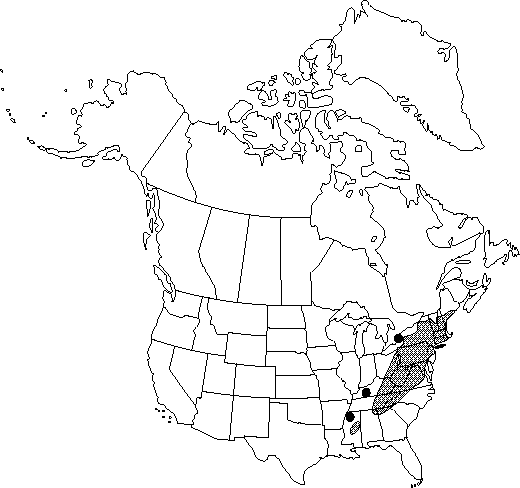Difference between revisions of "Betula lenta"
Sp. Pl. 2: 983. 1753.
FNA>Volume Importer |
FNA>Volume Importer |
||
| Line 21: | Line 21: | ||
}}<!-- | }}<!-- | ||
| − | --><span class="statement" id="st- | + | --><span class="statement" id="st-undefined" data-properties=""><b>Trees,</b> to 20 m; trunks tall, straight, crowns narrow. <b>Bark</b> of mature trunks and branches light grayish brown to dark brown or nearly black, smooth, close, furrowed and broken into shallow scales with age. <b>Twigs</b> with taste and odor of wintergreen when crushed, glabrous to sparsely pubescent, usually covered with small resinous glands. <b>Leaf</b> blade ovate to oblong-ovate with 12–18 pairs of lateral veins, 5–10 × 3–6 cm, base rounded to cordate, margins finely and sharply serrate or obscurely doubly serrate, teeth fine, sharp, apex acuminate; surfaces abaxially mostly glabrous, except sparsely pubescent along major veins and in vein axils, often with scattered, minute, resinous glands. <b>Infructescences</b> erect, ovoid to nearly globose, 1.5–4 × 1.5–2.5 cm, usually remaining intact for a period after release of fruits in fall; scales mostly glabrous, lobes diverging at or proximal to middle, central lobe short, cuneate, lateral lobes extended to slightly ascending, longer and broader than central lobe. <b>Samaras</b> with wings narrower than body, broadest near center, not extended beyond body apically. <b>2n</b> = 28.</span><!-- |
-->{{Treatment/Body | -->{{Treatment/Body | ||
| Line 53: | Line 53: | ||
|publication year=1753 | |publication year=1753 | ||
|special status=Endemic | |special status=Endemic | ||
| − | |source xml=https://jpend@bitbucket.org/aafc-mbb/fna- | + | |source xml=https://jpend@bitbucket.org/aafc-mbb/fna-data-curation.git/src/9216fc802291cd3df363fd52122300479582ede7/coarse_grained_fna_xml/V3/V3_345.xml |
|subfamily=Betulaceae subfam. Betuloideae | |subfamily=Betulaceae subfam. Betuloideae | ||
|genus=Betula | |genus=Betula | ||
|species=Betula lenta | |species=Betula lenta | ||
| − | |||
| − | |||
| − | |||
| − | |||
| − | |||
| − | |||
| − | |||
| − | |||
| − | |||
| − | |||
| − | |||
| − | |||
| − | |||
| − | |||
| − | |||
| − | |||
| − | |||
| − | |||
| − | |||
| − | |||
| − | |||
| − | |||
| − | |||
| − | |||
| − | |||
| − | |||
| − | |||
| − | |||
| − | |||
| − | |||
| − | |||
| − | |||
| − | |||
| − | |||
| − | |||
| − | |||
| − | |||
| − | |||
| − | |||
| − | |||
| − | |||
| − | |||
| − | |||
| − | |||
}}<!-- | }}<!-- | ||
-->[[Category:Treatment]][[Category:Betula]] | -->[[Category:Treatment]][[Category:Betula]] | ||
Revision as of 13:38, 27 July 2019
Trees, to 20 m; trunks tall, straight, crowns narrow. Bark of mature trunks and branches light grayish brown to dark brown or nearly black, smooth, close, furrowed and broken into shallow scales with age. Twigs with taste and odor of wintergreen when crushed, glabrous to sparsely pubescent, usually covered with small resinous glands. Leaf blade ovate to oblong-ovate with 12–18 pairs of lateral veins, 5–10 × 3–6 cm, base rounded to cordate, margins finely and sharply serrate or obscurely doubly serrate, teeth fine, sharp, apex acuminate; surfaces abaxially mostly glabrous, except sparsely pubescent along major veins and in vein axils, often with scattered, minute, resinous glands. Infructescences erect, ovoid to nearly globose, 1.5–4 × 1.5–2.5 cm, usually remaining intact for a period after release of fruits in fall; scales mostly glabrous, lobes diverging at or proximal to middle, central lobe short, cuneate, lateral lobes extended to slightly ascending, longer and broader than central lobe. Samaras with wings narrower than body, broadest near center, not extended beyond body apically. 2n = 28.
Phenology: Flowering late spring.
Habitat: Rich, moist, cool forests, especially on protected slopes, to rockier, more exposed sites
Elevation: 0–1500 m
Distribution

Ont., Ala., Conn., Ga., Ky., Maine, Md., Mass., Miss., N.H., N.J., N.Y., N.C., Ohio, Pa., R.I., S.C., Tenn., Vt., Va., W.Va.
Discussion
Betula lenta is a dominant tree in the northern hardwood forests of the northern Appalachians and a valuable source of timber. It was formerly the chief commercial source of wintergreen oil (methyl salicylate), which is distilled from its wood. Betula lenta is most easily separated from B. alleghaniensis by its close bark and the glabrous scales of infructescences.
Native Americans used Betula lenta medicinally to treat dysentery, colds, diarrhea, fevers, soreness, and milky urine, and as a spring tonic.
Selected References
None.